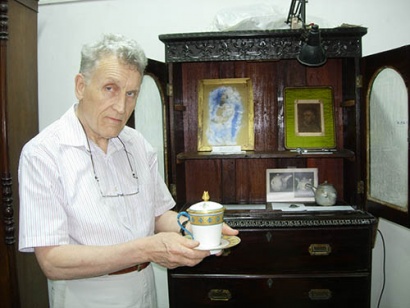Cup and Saucer (phenomenon)

On October 3, 1880, in a picnic-breakfast organized by Mr. A. P. and Mrs. Patience Sinnett at Simla, Madame Blavatsky was responsible for a phenomenon involving a cup and saucer.
C. Jinarājadāsa described the object:
It is evidently not an ordinary cup. but a chocolate or bouillon cup with a lid. Its pattern is turquoise blue (not green as Colonel Olcott says) with fleur-de-lys stamped in gold. The height of cup with lid on and saucer is 6½ inches, and the diameter of the saucer 6⅞ inches. The bottoms of the cup and saucer bear a red impress: “Paris. Ernie Fils et Patoneille, Rue Paradis 20. Exposition Univ. 1878. Medaille d’Argent."[1]
In a letter dated October 4, 1880, Colonel Olcott wrote to Damodar K. Mavalankar:
Great day yesterday for Madame’s phenomena. In the morning she, with Mr. and Mrs. Sinnett, Major Henderson, Mr. Syed Mahmood (District Judge, Rai-Bareilly), Mrs. Reed of Ajmere, and myself went on a pic-nic. Although she had never been at Simla before, she directed us where to go, describing a certain small mill which the Sinnetts, Major Henderson, and even the jampanis (palki-wallahs)[2] affirmed, did not exist. She also mentioned a small Tibetan temple as being near it. We reached the spot she had described and found the mill — at about 10 A. M.; and sat in the shade and had the servants spread a collation. Mr. Mahmood had joined our party after the baskets were packed and so when we wanted to have tea we found we were one cup and saucer short. Somebody asked Madame Blavatsky to produce one by magic. She consented; and, looking about the ground here and there, finally called Major Henderson to bring a knife and dig in a spot she pointed to. He found the ground hard and full of small roots of a young cedar tree near by. These he cut through and pulled up to a depth of say 6 inches, when something white was seen in the black soil; it was dug out, and lo! a cup decorated in green and gold, exactly matching the others Mrs. Sinnett’s servants had brought. Madame told the Major to dig more; he did so, and at last found a saucer to match the cup! They were embedded in the ground like stones naturally there, and the cedar roots grew all around them like a net work, and one root as large as your little finger had to be cut away to get at the saucer.[3]
Notes
- ↑ C. Jinarājadāsa, "The Early History of the T.S.: XVIII The Cup and Saucer Phenomenon" The Theosophist 47.1 (October, 1925), 69-70.
- ↑ The Palki is a sedan chair carried by two men, who are called "palkiwallahs." The seat is suspended by ropes from a bamboo stick, which is lifted by them on a shoulder at the two ends of the stick.
- ↑ Henry Steel Olcott letter to Damodar K. Mavalankar. October 4, 1880. Quoted by C. Jinarājadāsa in "The Early History of the T.S.: XVIII The Cup and Saucer Phenomenon" The Theosophist 47.1 (October, 1925), 70-71.